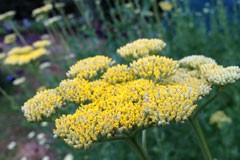
Primula auricula 'Pink Coffee'
A pretty variety we raised a few years ago from experimental crosses, with some creative contributions from our staff for the name. Good clumping habit and a subtle colour.


Tall, sun loving perennial for the herbaceous border and cottage garden, providing lasting structure and a long show of golden ochre flowers. Plant with heleniums, day lilies, iris and salvias.
Tall, sun loving perennial for the herbaceous border and cottage garden, providing lasting structure and a long show of golden ochre flowers. Plant with heleniums, day lilies, iris and salvias.
Data sheet
A pretty variety we raised a few years ago from experimental crosses, with some creative contributions from our staff for the name. Good clumping habit and a subtle colour.
Vigourous old fashioned mop top type, pure white flowers, useful for specimen or border plantings. Strong stemmed upright variety, useful for floral work.
White flowers suffused with the palest lilac, darkest at the tips. Tall stems great for flower arranging. Amongst my current favourites.
White double flowers. Strongly clumping variety useful as a cut flower or cottage garden background infill perennial; easy and prolific. Stake in windy areas or cram in between miscanthus and eupatorium.
One of the most beautiful agastache we have trialled, raised by Lambley Nursery. Tall and profusely flowering, best sited amongst grasses and taller perennials such as helenium and veronicastrum for background effect, loves good soil and fertility and needs a good cutback after flowering.
Old fashioned shade-loving primrose with burgundy gold edged flowers. Choice and lovely.
Fantastic perennial unlike anything else. Large yellow sombrero-shaped daisies on 1.8 metre stems with large blue grey leaves. Focal point for the back of a mixed border or a feature in a prairie garden.
Superb dark foliage variety, slightly darker in colour than 'Purple Emperor' with a strong mounding habit.
Reputedly more blue than others, we find these echinops, contrary to their appearance, are best situated in a cooler position with only part day sun. To yield their best, plant in fertile drained soil and a sheltered position.
Native of North America growing on forest margins, forming good spreading groundcover. Evergreen foliage and cream bells, extremely cold hardy.
Herbaceous variety with deep purple foliage through summer into autumn.
Aquilegia caerulea cultivar, long spurred pure white flowers in spring. Aquilegias look lovely in mass plantings under trees in a woodland setting.
Upright intermediate between 'Autumn Joy' and 'Purple Emperor', green foliage infused with purple, darkening as the season progresses. Rich pink and rose colours late in summer, wonderful amongst grasses and salvias.
A shorter more compact form of the tall officianalis equally hardy and prolific, only growing to 80cm. Purple pom poms throughout summer, a good improvement for windy locations.
Often listed incorrectly as Pratia puberula; indigenous to NSW, a vigourous trailing groundcover for shady areas. Effective at suppressing weeds and performs well as mass plantings, starry light blue campanulate flowers borne over a long period. Use in combinaton with viola, epimedium, hosta.
An easily grown long flowering bushy perennial for a sunny spot, repeat flowers during summer and early winter if dead headed. A fine backdrop for lower perennials and fills out well between roses and salvias.

Tall, sun loving perennial for the herbaceous border and cottage garden, providing lasting structure and a long show of golden ochre flowers. Plant with heleniums, day lilies, iris and salvias.